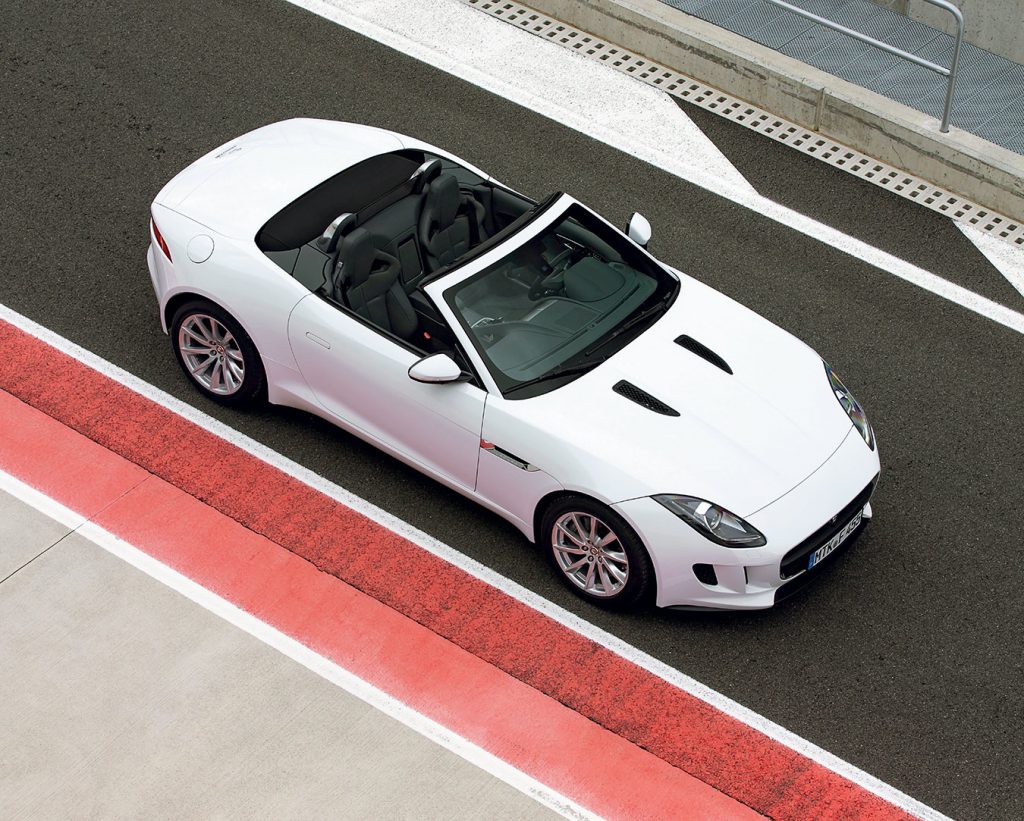Jaguar’s advanced design director Julian Thomson is standing in front of a video display in the still-as-it-was chapel of a former nunnery, now the Hotel Nun in Assisi, Italy. He is explaining the challenges of designing the latest in what has been, since William Lyons created the first XK-120 back in 1949, an iconic line of two-seater sports coupes. “The process, from inception to showroom, can be seven or eight years’ duration. So we must account for the car to look great for upwards of 20 years, really. And of course, take into account the vehicle’s DNA.” He pauses briefly, knowing that the assembled are really wanting nothing more than to get behind the wheel of one of these Jaguar F-Types, 10 of which are waiting outside the chapel doors, and take off into the surrounding hills and curvy roads.
The Umbrian hills constitute an ideal place to put this car through its paces, with hairpin turns, picturesque villages, and the occasional stretch of Autostrade built into the itinerary allowing for some full-throated roaring, all part of a driving palate that makes this an exciting machine. Stops along the day’s drive include a lunch stop at Lungarotti Winery, where proprietor Teresa Severini reveals the family’s personal wine library. She a force; alongside her sister Chiara, she manages the family company and sends everyone packing with a bottle of wine, since there is no drinking it during the drive.
The car overtly draws attention along the way, but the real pleasure of its performance is on the almost empty hillside roads, with steep cliffs usually on one side of these narrow pathways and rising rock faces on the other. It is exhilarating to push the car just a little, and allow all that technology and engineering to play itself out in real time.
And what about that technology? Thomson, over lunch at the Urbani Truffles facility on the second day of this test drive, says it is now possible to make a car that retains the original Jaguar design flair, but with an engine and overall vehicle that combines performance and safety at unprecedented levels. “For us, this is a statement car, proof that Jaguar is alive and well, and ahead of the game,” he says. F-Type, F-Type S, and F-Type V8 S are the three iterations of the car upon initial launch. Each is distinguished by a supercharged gasoline engine, either the completely new 3.0-litre V6 or the 5.0-litre V8.
Jaguar’s expertise in light but rigid aluminum alloys means a car that is both lighter and more powerful (yes, faster!) with a lower centre of gravity, resulting in great road feel and driver security. Composite materials, particularly aluminum alloys, including over 50 per cent of the car being built from recycled materials, mean the ecology factor is greatly enhanced as well. Those eight years—the time from drawing board to showroom—seem to have paid off.
The final evening of this grand driving tour is spent at dinner in the residence of the British Ambassador to Italy. The splendid grounds and grand buildings make it a nearly surreal setting, right in the heart of Rome. A string quartet embosses the evening air, but this is, after all, about cars. There on the lawn sit three vintage Jaguar two-seater sports coupes from 1959, 1966, and 1970. All three are classics, still beautiful, and certain of the assembled guests wax sentimental over these cars. But there is also an F-Type nearby, and upon close inspection, certain design flourishes from the older cars announce themselves on this brand-new one. It is perhaps most clear at the rear of the car, where the tail-light assembly and exhaust configuration show themselves to be right out of the 1950s. So when you take your F-Type up to Whistler one day, you can easily imagine driving in the Le Mans races of 1951 and 1953. Jaguars won them both.










